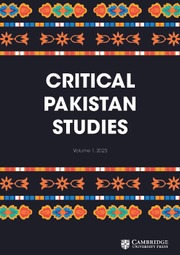The intention of Esha Niyogi De’s book Women’s Transborder Cinema: Authorship, Stardom, and Filmic Labor in South Asia is to interrogate borders: national, cinematic, thematic, conceptual, and embodied. Examining fictional cinema in Bangladesh, India, and Pakistan, her focus on women on “both sides of the camera” analyzes cinematic practices from multiple perspectives—ranging from production, directorship, and inter-textual to reception—and complicates simplistic readings and assumptions regarding gender, power, desire, and space.Footnote 1 De brings together several theoretical frameworks, including feminism, Marxian political economy, Deleuze’s notion of assemblages, genre studies, and textual analysis. The book covers a period from the 1970s into the 2000s, examining domestic, (inter) and (trans)national exigencies, negotiations, and opportunities. It joins a growing body of scholarship on Pakistani cinema and builds on Mushtaq Gazdar’s Pakistan Cinema 1947–1997 as well as more recent studies by Ali Nobil, Shehram Mokhtar, Zebunnisa Hamid, and Kamran Asdar Ali, among others.Footnote 2 One of the book’s outstanding features, which it shares with Loose Canons & Dangerous Curves: An Unholy Bible of Pakistani Popular Cinema, is its recognition of popular cinema as a complexly gendered site and practice.Footnote 3
De turns to “hidden” and “fugitive” archives to excavate both theory and history. At the very outset of this work, De tells the reader how it was her interview with Samina Peerzada, a Pakistani film producer, director, actress, and TV personality that made her change direction and recognize the need to pivot theoretically and methodologically. This motivated De’s “messy” archives, which refuse conventional ordering and established norms of interpreting space, place, and gender; they bring together ethnography, oral history, film journalism, videography (and its smuggling), and scopic analyses of film segments creatively. Ethnography and oral histories are especially important, as these allow De to go beyond masculinist biases in the writing of this film history.
De presents a complex reading of feminism, demonstrating how women work across the gender divide to create a space for women that is material and representational; that women’s labor, work alongside men, and mass-mediated presence on the screen as star actors strengthens their position as film producers and directors. Furthermore, De argues that small-scale production allows women greater control over both their image and work: that the movement away from the local to global film production beyond regional markets is double edged in its affordances for women in cinema.
Divided into three parts, “Maternal Modes and Infrastructural Access,” “Corporeal Modes and Scales of National Labor,” and “Familial Modes and Scales of Transnational Crossing,” the analysis moves from local to (trans)national and international scales (not necessarily in that order). While its theoretical scale is perhaps too broad, the actual scope of the book is modest. The analysis is primarily based on case studies of women as producers-directors-actors. Part I relies on public and private “maternities” in Kolkata and Dhaka; Part II addresses bodies and performances at multiple scales—local, national, and international—using cases from Lahore studios and Hindi Cinema; and Part III (re)turns to border crossings, this time those between Pakistan and Bangladesh, and across the borders of West and East Bengal. A range of eras are addressed from the 1970s to the present, allowing the author to integrate a broader historical and diverse linguistic landscape. De’s last section tracing the crossing of linguistic and state borders illustrates women filmmakers-stars transversal and transborder politics. These and the oral histories coupled with pirated videos and local media reports complicate our understanding and knowledge of the afterlives of film.
Building on earlier analyses in feminist film studies, refusing disciplinary theoretical and methodological closure, and engaging womens’ experiences in the industry both on and off screen allows De to tell the story of women in South Asian cinema in a manner both fresh and instructive. De challenges stereotypes of Muslim women (especially in Pakistani cinema), where they are often cast as victims or simply objects of the male gaze, instead underscoring women’s agency as both makers of and actors in film. By examining transborder connections among women in film, De affirms women’s work as a form transnational politics that unsettles national borders, designed to artificially sever historical and ongoing connections. However, despite its contribution to studies of small-scale, popular cinema and the dilemmas attendant on its internationalization, the work would have benefitted from a careful edit to erase unnecessary repetition of both certain terms and claims. This would have allowed for De’ sources to speak for themselves and helped her better make her case.

